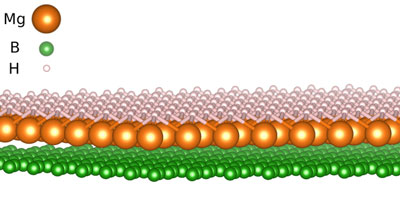| Aug 20, 2019 | |
Hydrogen induces high-temperature superconductivity in a monolayer material |
|
| (Nanowerk Spotlight) Various atomically-thin materials have excited the research community since the discovery of graphene in 2004. Not only are these materials stable albeit thinnest possible, they also often exhibit unprecedented electronic properties and hold promise for the ultimate miniaturization of portable electronic devices, sensors, satellites, as well as new technological breakthroughs. | |
| The latest addition in exciting properties of 2D materials has been superconductivity – the complete absence of resistance at low temperatures – clearly exciting for dissipationless (low-power, heating free) electronics. | |
| Superconductivity in itself has been known for over a century, understood to be based on electrons correlating their motion in so-called Cooper pairs, in a way that all participating electrons become correlated – which leads to the lossless flow of electricity. | |
| What correlates the motion of electrons distinguishes the kind of superconductor formed, but in most so-called ‘conventional’ superconductors the interaction of electrons with the ever-vibrating atomic lattice of the host material forms the 'glue' for the formation of Cooper-pair condensates. | |
| Obviously, with 2D materials exhibiting special electronic as well as vibrational properties, one can expect exciting superconducting properties to emerge as well. Still, to date, the temperature needed to achieve superconductivity in a 2D material remains rather low. | |
| As a recent breakthrough, a team of scientists from the University of Antwerp (Belgium) and Uppsala University (Sweden) has hypothesized that a layer of (light and small) hydrogen adatoms could strongly alter the electronic and vibrational features of an atomically thin material, thereby boosting its superconductivity. | |
| This idea was tested on a monolayer of magnesium diboride (see figure), where hydrogenation was demonstrated to elevate the temperature to where superconductivity appears above a hundred Kelvin – several times higher than in the absence of hydrogen! | |
 |
|
| Hydrogenated monolayer of magnesium diboride. (Image: University of Antwerp) | |
| “Using hydrogen for high-temperature superconductivity is not new”, recalls Milorad Milosevic, the team leader. “Hydrogen-rich bulk superconducting materials have recently exhibited record-breaking critical temperatures, nearing the ambient temperature. However, these hydrides have the practical disadvantage of requiring extremely high pressures to become superconducting. Our approach couples the best of both worlds – the host 2D material and the added hydrogen, circumventing the need for any applied pressure.” | |
| This new approach to achieve high-temperature superconductivity now remains to be applied to a number of ultrathin materials synthesized to date, holding promise for radical breakthroughs in novel heterostructured functional materials and their practical applications. | |
| A paper based on the study appeared in Physical Review Letters ("Hydrogen-Induced High-Temperature Superconductivity in Two-Dimensional Materials: The Example of Hydrogenated Monolayer MgB2"). | |
|
Provided by the University of Antwerp as a Nanowerk exclusive
|
|
|
Become a Spotlight guest author! Join our large and growing group of guest contributors. Have you just published a scientific paper or have other exciting developments to share with the nanotechnology community? Here is how to publish on nanowerk.com. |
|
